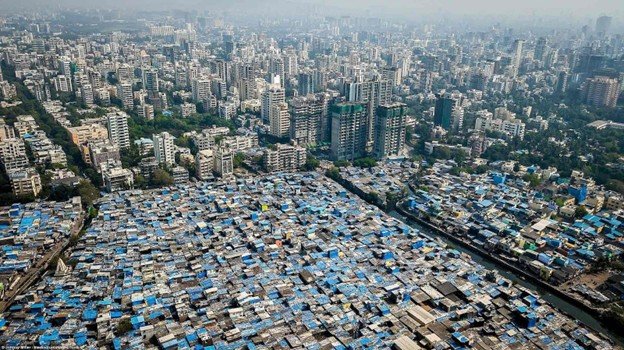“Between heritage and high-rise, can Dharavi’s beating heart survive?”
Introduction: Dreams of a New Dharavi
Dharavi is far more than a slum—it is a vibrant, self-sustained city within Mumbai, home to nearly one million people in just 2.1 square kilometers. Its informal economy, driven by industries such as leather, textiles, pottery, and recycling, generates over $1 billion annually, reaching markets globally. Forbes India describes Dharavi as “Asia’s largest slum but also one of its most productive urban hubs” (Forbes India, 2023).

Reference- filmingindo
The ambitious Dharavi Redevelopment Project, backed by the Adani Group and Maharashtra government through Navbharat Mega Developers Pvt Ltd (NMDPL), represents a ₹96,000 crore vision to modernize this urban hub. Plans include more than 20,000 new housing units, advanced sanitation systems, digital infrastructure, and modern commercial spaces (Economic Times, 2023).
However, redevelopment isn’t merely architectural—it’s deeply human. The project stirs uncertainties: Who will qualify for resettlement? Will informal economic networks survive vertical relocation?
Recent Developments and Eligibility Concerns
The state government’s recent release of a first eligibility list identified 59,631 slum households eligible for free housing, based on residency proof before January 1, 2000. Others face relocation to rental homes or public housing under the Pradhan Mantri Awas Yojana (PMAY) scheme (Times of India, 2024). However, only 101 of the 505 initially listed tenements from Meghwadi and Ganesh Nagar qualified for free in-situ housing. Others face fees or relocation, and a substantial 238 face exclusion due to insufficient documentation (Economic Times, 2025).
Activists like Raju Korde from Dharavi Bachao Andolan highlight that nearly 75% of Dharavi residents may be relocated outside their community, risking profound disruption to livelihoods and social structures (Times of India, 2025).
Livelihoods in Limbo: Economic Impacts
Redevelopment places Dharavi’s intricate economy at risk. Factory owners, artisans, and recyclers who operate within their residences face uncertain futures. As Liyaqat Ali, a local recycler, expressed: “We are resisting due to lack of clear communication from Adani and the government” (Scroll.in, 2024).
Craft communities, such as the potters in Kumbharwada, voice concerns about losing proximity to markets and disruption of their intricate economic ecosystems. Potter Sharifa Wagadiya encapsulates these fears, emphasizing the necessity for redevelopment to sustain livelihoods and community bonds (Al Jazeera, 2023).
Trust and Resistance: Community Dynamics
A significant barrier to redevelopment remains a lack of community trust. Shweta Damle from Habitat and Livelihood Welfare Association notes, “Surveyors have been refused entry… trust needs to be built first” (Scroll.in, 2024).
Politicians like Congress MP Varsha Gaikwad describe the project as a “mega land-grab,” urging greater transparency and public engagement under the Maharashtra Regional and Town Planning (MRTP) Act. Shiv Sena (UBT) MLA Aaditya Thackeray demands equal housing opportunities for all residents, reflecting widespread concerns over inequality (Times of India, 2025).
Land Acquisition and Environmental Concerns
Land acquisition, essential to the project’s success, remains contentious and unresolved, complicating rehabilitation plans for ineligible residents (Reuters, 2024). Additionally, environmental groups have expressed apprehension about redevelopment impacting salt pans and wetlands, essential ecological areas.
The Supreme Court of India has directed the Adani Group to respond to allegations regarding procedural fairness in contract tendering, adding another layer of complexity (Reuters, 2025).
Redevelopment vs. Rehabilitation
Adani and NMDPL propose providing 350 sq ft homes, commercial spaces, and rental housing for displaced residents. However, upper-floor units critical for workshops lack guarantees for affordable, long-term usage. Residents fear rent inflation and loss of multi-generational workspaces (Times of India, 2025).
Transparency and Governance
Though DRPPL has employed drone and LiDAR surveys and promises public consultations, completion rates remain low, and accusations of coerced paperwork have eroded public trust (Economic Times, 2025). Real-time community engagement remains crucial for sustainable redevelopment.
Recommendations for a Sustainable Redevelopment
Past failures, such as the 2004 Dharavi Redevelopment, highlight the necessity for phased development, inclusive eligibility criteria, affordable commercial spaces, transparent governance, and preservation of community structures. Ensuring livelihood continuity and environmental compliance remains paramount.
Conclusion: Preserving Dharavi’s Heartbeat
Ultimately, successful redevelopment hinges on incorporating Dharavi’s socio-economic fabric into its future design. Mumbai must commit not just to physical infrastructure but to the preservation of cultural and economic networks that sustain Dharavi’s unique vibrancy.
References
- Forbes India, 2023
- Economic Times, 2023, 2025
- Times of India, 2024, 2025
- Scroll.in, 2024
- Al Jazeera, 2023
- Reuters, 2024, 2025
